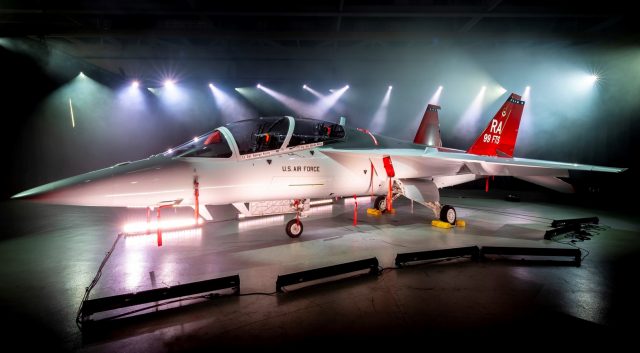Aerospace and defense major Boeing has shared the first photo of the first T-7A Red Hawk advanced trainer jet assembled for the US Air Force ahead of the official delivery.
The jet is one of 351 airframes expected to be ordered by the US Air Force as a replacement for the nearly 60-year-old T-38C Talon aircraft.
The T-7A Red Hawk that was unveiled on April 28 incorporates a red-tailed livery in honor of the Tuskegee Airmen of World War II. These airmen made up the first African American aviation unit to serve in the US military.
“The Tuskegee Airmen are one of the most celebrated units in our Air Force history, and the T-7A honors the bravery and skill of these trailblazers, said Gen. Charles Q. Brown, Jr., Chief of Staff of the Air Force. “Like the Airmen they were named and painted to pay homage to, the T-7A Red Hawks break down the barriers of flight.”
The aircraft will remain in St. Louis where it will undergo ground and flight tests before being delivered to the US Air Force. The service announced earlier this month it began testing of on-board oxygen generation systems (OBOGS) that will be installed onto five T-7 aircraft for flight testing later this year.
The T-7A program resides at Boeing’s St. Louis facility with the aft section of the trainer being built by Saab in Linkoping, Sweden. Saab will soon start producing that section at their new production facility in West Lafayette, Indiana.
The fully digitally designed aircraft was built and tested using advanced manufacturing, agile software development and digital engineering technology significantly reducing the time from design to first flight.
This is why the Red Hawk is also designated “eT-7A“, as the first US Air Force aircraft designed using the digital approach. Model-based engineering and 3D design tools reduced assembly hours by 80% and cut software development time in half. The aircraft moved from computer screen to first flight in just 36 months, according to the service.
T-7A features twin tails, slats and big leading-edge root extensions designed to provide better handling at low speeds, allowing it to fly in a way that better approximates real world demands and is specifically designed to prepare pilots for fifth-generation aircraft. The aircraft’s single engine generates nearly three times more thrust than the dual engines of the T-38C Talon it is replacing.
In addition to the 351 trainers, Boeing will also be responsible for delivery of 46 ground-based training simulators under a $9.2 billion contract from September 2018.



























